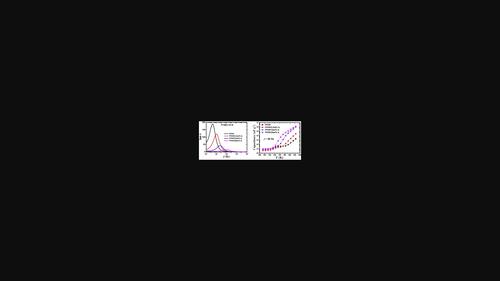当前位置:
X-MOL 学术
›
Polym. Adv. Technol.
›
论文详情
Our official English website, www.x-mol.net, welcomes your feedback! (Note: you will need to create a separate account there.)
Molecular dynamics and conduction mechanism of poly(vinyl chloride-co-vinyl acetate-co-2-hydroxypropyl acrylate) terpolymer containing ionic liquid
Polymers for Advanced Technologies ( IF 3.4 ) Pub Date : 2022-11-22 , DOI: 10.1002/pat.5932 Mahdy M. Elmahdy 1, 2 , Khalid A. Aldhafeeri 1 , Moustafa T. Ahmed 1, 3 , Maged A. Azzam 4 , Tarek Fahmy 3
Polymers for Advanced Technologies ( IF 3.4 ) Pub Date : 2022-11-22 , DOI: 10.1002/pat.5932 Mahdy M. Elmahdy 1, 2 , Khalid A. Aldhafeeri 1 , Moustafa T. Ahmed 1, 3 , Maged A. Azzam 4 , Tarek Fahmy 3
Affiliation

|
Dielectric spectroscopy (DS) measurements were performed to probe the segmental dynamics and ion mobility of poly(vinyl chloride-co-vinyl acetate-co-2-hydroxypropyl acrylate) terpolymer dopped with different amounts of tetrabutylammonium tetrafluoroborate ([TBA] [BF4]) ionic liquid (IL). Differential scanning calorimetry (DSC) was also employed to trace the change in the glass transition temperature (Tg) at different loads of IL. The DSC measurements revealed a remarkable reduction in the PVVH Tg from 344 to 310 K just by adding 20 wt% of IL. The DS measurements revealed three relaxation processes named α, β1, and β2. The α-process is related to the segmental motion of PVVH while the β1 and β2 are due to the restricted local dynamics of side chains. The segmental relaxation times (α-relaxation) speed up with increasing the concentration of IL due to the plasticization effect of IL on polymer chains. The temperature dependence of α-relaxation follows the Vogel-Fulcher-Tammann (VFT) relation with dynamic glass transition between 323 and 294 K in agreement with the DSC measurements. The β1 and β2-relaxations have an Arrhenius temperature dependence. The temperature dependence of ionic conductivity obeys the VFT behavior indicating the coupling between the segmental motion of PVVH chains and ion transport. Polaronic tunneling is the predominant conduction mechanism in PVVH and its composites. The specific capacitance increases with increasing both the temperature and IL concentration.
中文翻译:

含离子液体的聚(氯乙烯-co-乙酸乙烯酯-co-2-羟丙基丙烯酸酯)三元共聚物的分子动力学及传导机制
进行介电光谱 (DS) 测量以探测掺杂有不同量的四丁基四氟硼酸铵 ([TBA] [BF 4 ] ) 离子液体 (IL)。还采用差示扫描量热法 ( DSC ) 来追踪不同 IL 负载下玻璃化转变温度 ( Tg ) 的变化。DSC 测量显示,仅通过添加 20 wt% 的 IL,PVVH T g从 344 显着降低至 310 K。DS 测量揭示了三个弛豫过程,分别称为α、β 1和β 2。这α-过程与 PVVH 的分段运动有关,而β 1和β 2是由于侧链的局部动力学受限。由于 IL 对聚合物链的塑化作用,分段弛豫时间(α -弛豫)随着 IL 浓度的增加而加快。α-弛豫的温度依赖性遵循 Vogel-Fulcher-Tammann (VFT) 关系,动态玻璃化转变在 323 和 294 K 之间,与 DSC 测量结果一致。β 1和β 2 _-弛豫具有阿伦尼乌斯温度依赖性。离子电导率的温度依赖性服从 VFT 行为,表明 PVVH 链的分段运动与离子传输之间的耦合。极化隧道效应是 PVVH 及其复合材料中的主要传导机制。比电容随着温度和 IL 浓度的增加而增加。
更新日期:2022-11-22
中文翻译:

含离子液体的聚(氯乙烯-co-乙酸乙烯酯-co-2-羟丙基丙烯酸酯)三元共聚物的分子动力学及传导机制
进行介电光谱 (DS) 测量以探测掺杂有不同量的四丁基四氟硼酸铵 ([TBA] [BF 4 ] ) 离子液体 (IL)。还采用差示扫描量热法 ( DSC ) 来追踪不同 IL 负载下玻璃化转变温度 ( Tg ) 的变化。DSC 测量显示,仅通过添加 20 wt% 的 IL,PVVH T g从 344 显着降低至 310 K。DS 测量揭示了三个弛豫过程,分别称为α、β 1和β 2。这α-过程与 PVVH 的分段运动有关,而β 1和β 2是由于侧链的局部动力学受限。由于 IL 对聚合物链的塑化作用,分段弛豫时间(α -弛豫)随着 IL 浓度的增加而加快。α-弛豫的温度依赖性遵循 Vogel-Fulcher-Tammann (VFT) 关系,动态玻璃化转变在 323 和 294 K 之间,与 DSC 测量结果一致。β 1和β 2 _-弛豫具有阿伦尼乌斯温度依赖性。离子电导率的温度依赖性服从 VFT 行为,表明 PVVH 链的分段运动与离子传输之间的耦合。极化隧道效应是 PVVH 及其复合材料中的主要传导机制。比电容随着温度和 IL 浓度的增加而增加。



























 京公网安备 11010802027423号
京公网安备 11010802027423号